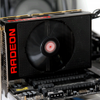Introduction
The AMD Radeon R9 NANO analyzed
Tiny while offering serious muscle
Small, tiny and cute are the keywords for the AMD Radeon R9 Nano that we review today. The product has an incredibly small form factor design yet is powered with a contradictorily huge Fiji XT chip that brings some significant gaming performance to this graphics card. With the release of the Nano, AMD now offers three graphics cards in their FIJI GPU line-up being the liquid cooled Radeon R9 Fury X with a FIJI XT GPU, the 'regular' Radeon R9 Fury with the FIJI PRO GPU, and today we can bring you a review on the NANO, powered by a fully enabled FIJI XT GPU. That Fiji XT GPU is literally a beast in size and performance as it is still based on a 28nm fabrication node, a chip that measures just over 5 x 5cm in size. There's lots of good stuff going on inside that chip as the memory you guys all know as GDDR5 typically has been seated on the graphics card PCB.
Well, with the Radeon R9 Fury, Fury X and NANO that has changed. AMD moved towards HBM memory in their entire enthusiast class product stack, the 4 GB of memory is seated onto the actual GPU (chip). So, the Fiji XT GPU has 8.9 Billion transistors, and that is EXCLUDING the HBM memory chips. The GPU the NANO uses is based on GCN 1.2 architecture and then scaled upwards (GCN Gen3) with pretty good DirectX 12 support. The Radeon R9 NANO screams multitudes of 4096 in the sense that you can game at 4K Ultra HD, it has 4096 shader processors, comes with 4096 MB of graphics memory and sure, why not... it has a 4096-bit wide memory bus. The end result is a product that offers roughly 8 TFLOPS of compute and graphics rendering performance offering excellent game performance in the more difficult and complex to render circumstances, such as Ultra HD gaming. The AMD Radeon R9 Nano will be a 175W TDP graphics card based on a very small form factor, you can use it inside a mini-ITX or Micro ATX build easily. The fully enabled Fiji XT GPU has 4096 stream processors - 256 TMUs and 64 ROPs.
So how does AMD do all that, such a big and hot ship running at a lower TDP in a small design graphics card? Well, while the core clock frequency is allowed to boost up-to 1 GHz, the card has both a power limiter and temperature limiter. Once it reaches 75 Degrees C or a certain power allowance, it will start to down-clock to reach the pre-programmed power and temperature targets. As such the 1000 MHz core clock frequency is not a fixed clock on these cards, it is a maximum clock frequency -- if the card passes its power limitations or gets too warm then the card will clock up/down in-between these monitored limiters. In our experience you are looking at anywhere from 5 to 15% of the clock frequency, based on the limiters. Have a peek at the product we test today and then head onwards into the review.


